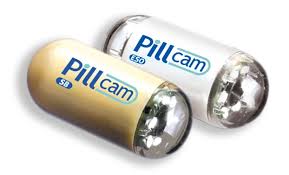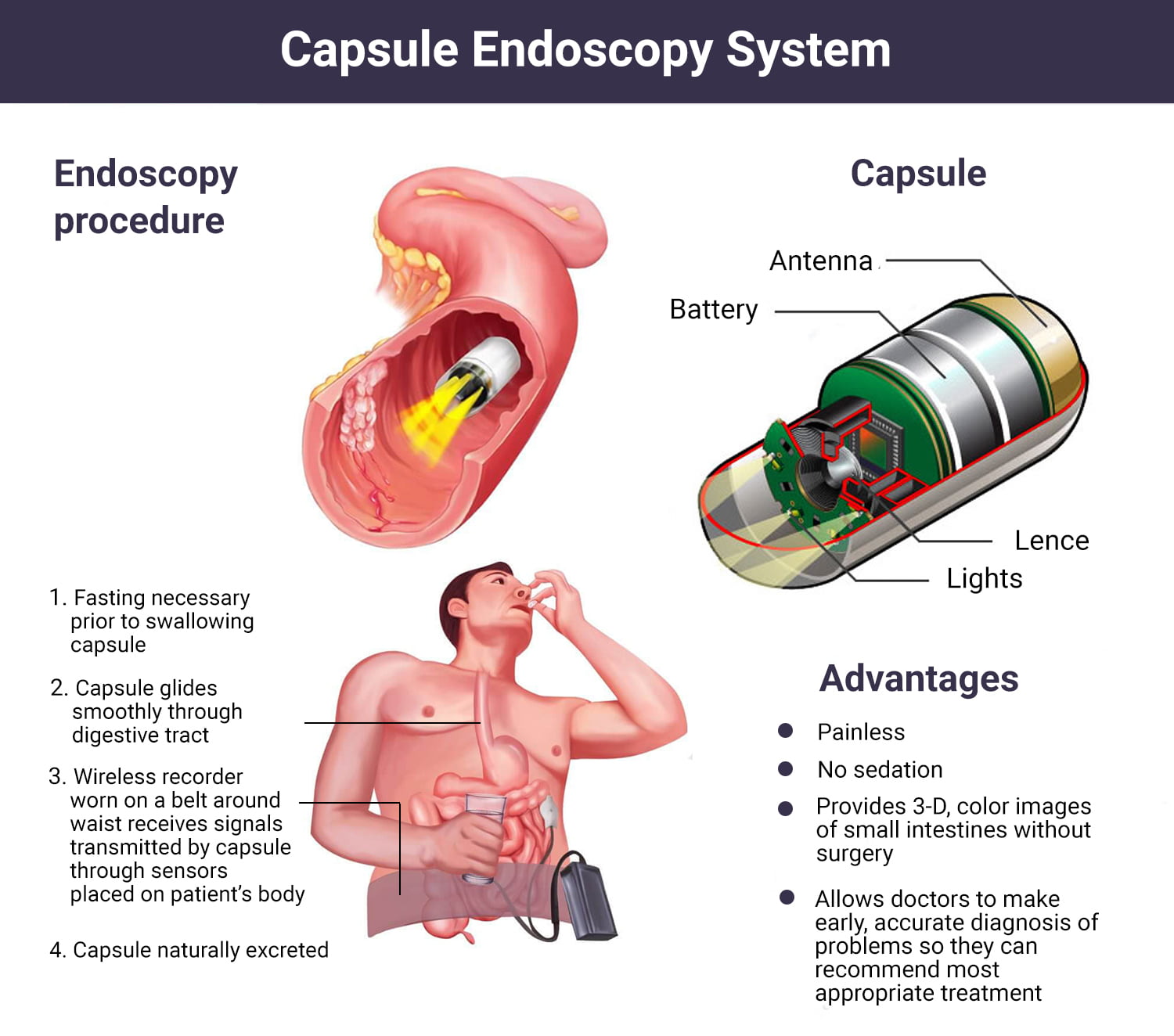Performed in our offices in Union Square/Chelsea, Midtown, Financial District, and the Upper East Side, NY, capsule endoscopy allows taking images of the gastrointestinal tract insides and using them for medical diagnosis. Our team of highly skilled gastroenterologists provides state-of-the-art procedures at Manhattan Gastroenterology. For more information or to schedule an appointment, please get in touch with one of our offices.
What Is Capsule Endoscopy?
 Endoscopy means “seeing inside” in Latin. The procedure allows your healthcare provider to see the inner surfaces of your gastrointestinal tract. The kind of camera involved, sometimes called a pill cam, makes capsule endoscopy different from conventional tube endoscopy. With capsule endoscopy, you swallow a tiny camera encased in a clear, smooth shell. The camera takes pictures of your digestive system as it moves down your esophagus, into your stomach, and through your small intestine.
Endoscopy means “seeing inside” in Latin. The procedure allows your healthcare provider to see the inner surfaces of your gastrointestinal tract. The kind of camera involved, sometimes called a pill cam, makes capsule endoscopy different from conventional tube endoscopy. With capsule endoscopy, you swallow a tiny camera encased in a clear, smooth shell. The camera takes pictures of your digestive system as it moves down your esophagus, into your stomach, and through your small intestine.
As the pill-sized camera moves through your digestive system, it transmits thousands of images to a recording device you wear around your waist or neck. At Manhattan Gastroenterology, we offer services based on the indication and will gladly discuss its uses with you in detail.
What Can Capsule Endoscopy Do It and Why Is It Beneficial?
Traditional endoscopy and colonoscopy procedures allow your doctor to check the upper and lower portions of your gastrointestinal tract, but cameras cannot view the middle portions, which include the duodenum, jejunum, and ileum of the small intestine. Capsule endoscopy sheds light on the middle regions of the gastrointestinal tract without exploratory surgery. Swallowing the tiny camera can reveal the source of gastrointestinal bleeding, detect bowel inflammation from Crohn’s disease, find tumors, and see ulcers. People with celiac disease can benefit from this type of endoscopy by getting a definitive diagnosis and monitoring intestinal inflammation without an invasive procedure.
What Happens During Capsule Endoscopy?
The procedure is almost as simple as swallowing a pill the size of a large vitamin tablet. Still, this capsule contains lights, a wireless transmitter, and a camera housed in clear plastic. GI doctors ill fit you with a monitoring device to wear while the pill moves through your GI tract. Some monitors are connected to adhesive patches that your doctor will place on your abdomen. You will wear the monitoring device for the next 12 hours as the capsule passes slowly through your gastrointestinal tract.
★ ★ ★ ★ ★I was experiencing a lot of discomfort, and my doctor recommended Manhattan Gastroenterology for me. I went there, and they recommended I have an endoscopy. It was not nearly as uncomfortable an experience as I thought, and the facility was very modern. They discovered that I had gastritis and recommended some changes in my diet, and told me to avoid stress. If I ignored it, it could have become worse. I feel much better today, thanks to this gastroenterologist.
You will not feel any unusual sensations during the test, but the camera you have swallowed will be working overtime. During a typical test, the camera takes about 50,000 pictures of your stomach and intestinal walls. The LED lights in the capsule, like a camera flash, provide light for the images that the camera takes and transmits to the small monitoring device you wear.
After the wireless camera has completed its tour of your stomach, small intestine, and colon, the doctor will expel it. The capsule may emerge after a few hours or may not appear for up to 72 hours. Both possibilities are normal. You do not need to retrieve the camera because it is disposable and may be flushed. The monitoring device, not the capsule, keeps the data it gathered.
How to Prepare for Capsule Endoscopy?
You should consult the physician performing this exam for special preparation instructions based on your specific case. The camera capsule works best in an environment free of matter that could obscure the lens. Hence, your doctor will probably recommend you to drink only clear liquids for 24 hours before the test and only water on the day of the procedure. Some physicians suggest a laxative before the examination for better visual.
It would be helpful if you discussed specific instructions with the performing gastroenterologist. Please discuss any medications you are taking with your practitioner. Some of them may need to be adjusted or temporarily discontinued for your test. Some common medications, such as nonsteroidal anti-inflammatory drugs, aspirin, bismuth subsalicylate antacids, and iron supplements, can obscure test findings. Please speak with your doctor about your medication regimen.

Your doctor will apply the adhesive sensors that detect the camera’s transmissions and send them to the recording device on the day of the procedure.
The monitoring device is about the size of a tiny CD player and is worn around the waist with hook-and-loop fasteners. Once your monitoring system is in place, you are ready for the camera capsule.
The pill-sized camera is a little larger than a typical multivitamin tablet and should be easy for most patients to swallow. It has a slippery coating to help it go down more easily, and you can leave the office once the health expert confirms that the capsule is in place and functioning properly.
While undergoing a capsule endoscopy, follow your doctor’s instructions for eating and drinking. In general, you can have clear liquids for the first two hours after swallowing the pill and have a light meal four to six hours later. Your doctor may recommend you avoid strenuous activity that could result in blurred images, but you should be able to carry on with your normal routine until the test is finished.
What to Expect After the Procedure?
After approximately 12 hours, you can remove the sensor patches and pack them with the monitoring device according to your doctor’s directions. You will receive the test results after your healthcare provider uploads and analyzes the images. In most cases, you will receive a phone call with your results within a few days to a week. However, some diagnoses take longer.
Advantages of Capsule Endoscopy
Because capsule endoscopy, oes not entail anesthesia, there is no recovery period after the procedure. For many patients, swallowing a pill is far more pleasant than undergoing conventional endoscopy. The middle portions of your gastrointestinal tract are difficult to see by other means, but capsule endoscopy creates a detailed, up-to-date image of your intestinal lining. Conditions that can be challenging to diagnose by other means are often readily revealed by capsule endoscopy.
Limitations of Capsule Endoscopy
To compensate for the limitations of capsule endoscopy, your doctor may recommend additional testing. Because the wireless camera capsule is not under voluntary control, the images it captures may not adequately highlight an area of interest, necessitating further testing. Unlike traditional endoscopy, the camera can only record, so this procedure does not allow for a biopsy or the removal of a polyp. Slow transit can also be a limitation. Sometimes the capsule moves slowly through the bowel and does not examine the entire small bowel before the battery dies. There may also be missed lesions due to irregularities in areas of the small intestine that can be missed either because of inconclusive imaging or rapid transit.
How Much Does This Test Cost?
Without insurance, capsule endoscopy can cost anywhere from $900 to $2,625 on average. The capsule itself might cost between $500 to $1,300. However, this is less expensive than a colonoscopy, which can range between $800 and $4000 or more. Some insurance policies may not cover this procedure. Check with your insurance company before scheduling to ensure that capsule endoscopy is covered.
Capsule Endoscopy Complications
Although complications with this non-invasive procedure are rare, we may not recommend it for some patients. If the capsule does not pass through the entire small intestine, you may require an XR to ensure that it is ultimately eliminated from your intestines. You should talk to your doctor about it.
Although complications can occur, they are rare when a specially trained and experienced gastroenterologist performs the test. However, there may be limitations and issues with its use, such as the following:
- Bowel obstruction – The most serious complication is if the capsule gets stuck inside your digestive tract in an area of narrowing, resulting in a bowel obstruction that may require surgical removal. This problem can happen in stricture or narrowing your digestive tract from inflammation, prior surgery, or tumor. It’s essential to recognize the obstruction early from symptoms such as unusual bloating, abdominal pain, nausea, or vomiting. Other complications include developing a fever after the test, having trouble swallowing, or experiencing chest pain. Call your doctor immediately if you have any such symptoms.
- Slow transit– Sometimes, the capsule moves slowly through the bowel and does not examine the entire small bowel before the battery dies
- Missed Lesions– There can be irregularities in areas of the small intestine that can be missed either because of inconclusive imaging or rapid transit
If you have any of these symptoms, call your doctor immediately. Also, please inform your doctor if you have a history of intestinal obstructions or adhesions or if you have a pacemaker. Your gastroenterologist at Manhattan Gastroenterology should help decide if a small bowel capsule is a right test for you in order to come to an accurate diagnosis and treatment plan.

